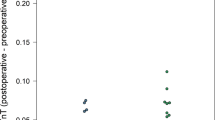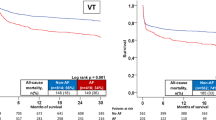Abstract
Ventricular tachycardia (VT) after palliative repair of congenital heart disease is relatively rare. Despite this rarity, VT is a known cause of early, intermediate and late morbidity and mortality in these patients. A number of factors have been linked to the development of VT in this unique patient population. The purpose of this article is to provide a concise overview regarding the etiology, diagnosis and treatment of VT in patients with congenital heart disease. In-depth information will be provided to aid diagnosis and the treatment of early postoperative VT. The use of additional diagnostic methods such as echocardiography, cardiac catheterization and electrophysiology studies to risk assess patients with postoperative VT will also be discussed. In addition, I examine the long-term management strategies for VT in these patients, from medical management and cardiovascular surgery to implantation of cardioverter-defibrillators.
Key Points
-
Ventricular arrhythmias can occur in all individuals who have undergone palliative surgery for congenital heart disease, and such arrhythmias are a significant source of early, intermediate and late morbidity and mortality
-
Familiarization with the patient's original anatomy, history of surgical repair or repairs, previous electrocardiograms, hemodynamic status and underlying rhythm is essential before diagnosing and treating ventricular tachycardia (VT)
-
For accurate diagnosis, VT must be distinguished from other cardiac dysrhythmias such as supraventricular tachycardia with bundle branch block
-
Echocardiography and/or cardiac catheterization can determine whether the patient has a hemodynamic issue
-
If a hemodynamic issue is found, and catheterization or surgery can be undertaken to correct the issue, then it is recommended the patient have a electrophysiology study at some point before hospital discharge
-
If the patient has 'normal' hemodynamics, the majority of electrophysiologists would recommend an electrophysiology study with aggressive ventricular stimulation—if VT is inducible then implantation of an implantable cardioverter-defibrillator is recommended; if VT is not induced, then close follow-up and consideration of medical management is required
This is a preview of subscription content, access via your institution
Access options
Subscribe to this journal
Receive 12 print issues and online access
$209.00 per year
only $17.42 per issue
Buy this article
- Purchase on Springer Link
- Instant access to full article PDF
Prices may be subject to local taxes which are calculated during checkout


Similar content being viewed by others
References
Gatzoulis MA et al. (2000) Risk factors for arrhythmia and sudden cardiac death late after repair of tetralogy of Fallot: a multicentre study. Lancet 356: 975–981
Deanfield JE et al. (1980) Detection of late arrhythmia and conduction disturbances after correction of tetralogy of Fallot. Br Heart J 44: 248–253
Vetter VL and Horowitz LN (1982) Electrophysiologic residua and sequelae of surgery from congenital heart defects. Am J Cardiol 50: 588–604
Webb Kavey RE et al. (1982) Incidence and severity of chronic ventricular dysrhythmias after repair of tetralogy of Fallot. Am Heart J 103: 342–350
Garson A et al. (1972) Status of adult and adolescent after repair of tetralogy of Fallot. Circulation 59: 1232–1240
Gillette PC et al. (1977) Sudden death after repair of tetralogy of Fallot: electrocardiographic and electrophysiologic abnormalities. Circulation 56: 566–571
Blake RS et al. (1982) Conduction defects, ventricular arrhythmias and late sudden death after surgical closure of ventricular septal defect. Br Heart J 47: 305–315
Snyder CS et al. (2007) Can pediatric electrophysiologists safely perform electrophysiology studies on adults with congenital heart disease? Ochsner J 7: 16–19
Walsh EP et al. (1988) Late results in patients with tetralogy of Fallot repaired during infancy. Circulation 77: 1062–1067
Delaney JW et al. (2006) Acute postoperative arrhythmias after cardiac surgery in children. J Thorac and Cardiovasc Surg 131: 1296–1300
Wessel H et al. (1980) Prognostic significance of arrhythmia in tetralogy of Fallot after intracardiac repair. Am J Cardiol 46: 843–848
Fuster V et al. (1980) Long-term evaluation (12 to 22 years) of open heart surgery for tetralogy of Fallot. Am J Cardiol 46: 635–642
Chandar J et al. (1990) Ventricular arrhythmias in postoperative tetralogy of Fallot. Am J Cardiol 65: 655–661
Wita K et al. (2006) Incessant ventricular tachycardia in a patient with a severe aortic stenosis successfully treated by cardiac surgery. Kardiol Pol 64: 441–444
Malhotra S et al. (2007) A case of congenitally corrected transposition of the great arteries with rare but life-threatening VT and a coincidental single coronary ostium. J Invasive Cardiol 19: 139–141
Snyder CS et al. (2007) Can pediatric electrophysiologists safely perform electrophysiology studies on adults with congenital heart disease? Ochsner J 7: 16–19
Janousek J et al. (1994) Atrial baffle procedures for complete transposition of the great arteries: natural course of sinus node dysfunction and risk factors for dysrhythmias and sudden death. Z Kardiol 83: 933–938
Kugler J et al. (1983) Sustained ventricular tachycardia after repair of tetralogy of Fallot: new electrophysiological findings. Am J Cardiol 51: 1137–1143
Denfield S et al. (1990) Growth in cardiac surgical scars with age: a canine model [abstract]. J Am Coll Cardiol 15: 176A
Khairy P et al. (2008) Implantable cardioverter-defibrillators in tetralogy of Fallot. Circulation 117: 363–370
Garson A et al. (1985) Prevention of sudden death after repair of tetralogy of Fallot: Treatment of ventricular arrhythmias. J Am Coll Cardiol 6: 221–227
Zahka R et al. (1988) Long-term valvular function after total repair of tetralogy of Fallot: relation to ventricular arrhythmias. Circulation 78: III14–III19
Berul C et al. (1997) Electrocardiographic markers of late sudden death risk in postoperative tetralogy of Fallot children. J Cardiovasc Electrophysiol 8: 1349–1356
Gatzoulis M et al. (1995) Mechanoelectrical interaction in tetralogy of Fallot: QRS prolongation related to right ventricular size and predicts malignant ventricular arrhythmias and sudden death. Circulation 92: 231–237
Balaji S et al. (1997) QRS prolongation is associated with inducible ventricular tachycardia after repair of tetralogy of Fallot. Am J Cardiol 80: 160–163
Garson A (1983) Arrhythmias. In The Electrocardiogram in Infants and Children: A Systematic Approach, 251–254 (Ed Garson A) Philadelphia: Lea and Febiger
Carboni M and Garson A (1998) Ventricular arrhythmias. In The Science and Practice of Pediatric Cardiology, edn 2, 2121–2168 (Eds Garson A. et al.) Baltimore: Williams and Wilkins
American Heart Association (2005) American Heart Association guidelines for cardiopulmonary resuscitation and emergency cardiovascular care of pediatric and neonatal patients: pediatric basic life support. Pediatrics 117: e989–e1004
Garson A (1983) Effects of systemic alterations on the electrocardiogram. In The Electrocardiogram in Infants and Children: A Systematic Approach, 173–178 (Ed Garson A) Philadelphia: Lea and Febiger
American Heart Association (2000) The International Liaison Committee on Resuscitation: Guidelines 2000 for cardiopulmonary resuscitation and emergency cardiovascular care: an international consensus on science. Part 5. Pharmacology 1: agents for arrhythmias. Circulation 102: 1112–1128
Kudenchuk P et al. (1999) Amiodarone for resuscitation after out-of-hospital cardiac arrest due to ventricular fibrillation. N Engl J Med 341: 871–878
Drago F et al. (1998) Amiodarone used alone or in combination with propranolol: a very effective therapy for tachyarrhythmias in infants and children. Pediatr Cardiol 19: 445–449
Yamawake N et al. (2007) Autonomic and pharmacological responses of idiopathic ventricular tachycardia arising from the left ventricular outflow tract. J Cardiovasc Electrophysiol 18: 1161–1166
Johnson MS et al. (2006) Cardioversion of supraventricular tachycardia using lidocaine in five dogs. J Vet Intern Med 20: 272–276
Khairy P et al. (2004) Value of programmed ventricular stimulation after tetralogy of Fallot repair: a multi center study. Circulation 109: 1994–2000
Alexander M et al. (1999) Value of programmed ventricular stimulation in patients with congenital heart disease. J Cardiovasc Electrophysiol 10: 1045–1048
Gonska B et al. (1996) Radiofrequency catheter ablation of right ventricular tachycardia late after repair of congenital heart defects. Circulation 94: 1902–1908
Morwood J et al. (2004) Radiofrequency catheter ablation of ventricular tachycardia in children and young adults with congenital heart disease. Heart Rhythm 1: 301–308
Stefanelli CB et al. (2002) Implantable cardioverter defibrillator therapy of life-threatening arrhythmias in young patients. J Interv Card Electrophysiol 6: 235–244
Park JK and Pollock ME (1999) Use of an implantable cardioverter defibrillator in an eight-month-old infant with ventricular fibrillation arising from a myocardial fibroma. Pacing Clin Electrophysiol 22: 138–139
Chevalier P et al. (1996) Symptomatic pericardial disease associated with patch electrodes of the automatic implantable cardioverter defibrillator: an underestimated complication? Pacing Clin Electrophysiol 19: 2150–2152
Korte T et al. (1995) Incidence of ICD lead related complications during long-term follow-up: comparison of epicardial and endocardial electrode systems. Pacing Clin Electrophysiol 18: 2053–2061
Kettering K et al. (2004) Long-term experience with subcutaneous ICD leads: a comparison among three different types of subcutaneous leads. Pacing Clin Electrophysiol 27: 1355–1361
Cannon B et al. (2006) Innovative techniques for placement of implantable cardioverter-defibrillator leads in patients with limited venous access to the heart. Pacing Clin Electrophysiol 29: 181–187
Snyder C et al. (2007) Minimally invasive implantation of a cardioverter-defibrillator in a small patient. J Thorac Cardiovasc Surg 133: 1375–1376
Berul C et al. (2004) Minimally invasive cardioverter defibrillator implantation for children: an animal model and pediatric case report. Pacing Clin Electrophysiol 24: 1789–1794
Author information
Authors and Affiliations
Ethics declarations
Competing interests
The author declares no competing financial interests.
Rights and permissions
About this article
Cite this article
Snyder, C. Postoperative ventricular tachycardia in patients with congenital heart disease: diagnosis and management. Nat Rev Cardiol 5, 469–476 (2008). https://doi.org/10.1038/ncpcardio1275
Received:
Accepted:
Published:
Issue Date:
DOI: https://doi.org/10.1038/ncpcardio1275



